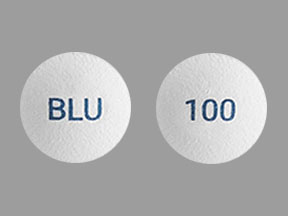Avapritinib Dosage
Medically reviewed by Drugs.com. Last updated on Feb 20, 2025.
Applies to the following strengths: 100 mg; 200 mg; 25 mg; 300 mg; 50 mg
Usual Adult Dose for:
Additional dosage information:
Usual Adult Dose for Gastrointestinal Stromal Tumor
300 mg orally once a day
Duration of therapy: Until disease progression or unacceptable toxicity
Comments:
- Select patients for treatment based on the presence of a platelet-derived growth factor receptor alpha (PDGFRA) exon 18 mutation.
- A test approved by the US FDA for the detection of exon 18 mutations is not currently available.
Use: For the treatment of unresectable or metastatic gastrointestinal stromal tumor (GIST) harboring a PDGFRA exon 18 mutation, including PDGFRA D842V mutations
Usual Adult Dose for Systemic Mastocytosis
ADVANCED SYSTEMIC MASTOCYTOSIS (AdvSM): 200 mg orally once a day
- Duration of therapy: Until disease progression or unacceptable toxicity
INDOLENT SYSTEMIC MASTOCYTOSIS (ISM): 25 mg orally once a day
Comments:
- Limitation of use: This drug is not recommended for the treatment of patients with AdvSM or ISM with platelet counts of less than 50 x 10(9)/L.
- Ensure a platelet count is performed prior to initiating therapy.
- This drug should be taken on an empty stomach.
Uses:
- For the treatment of AdvSM, including patients with aggressive systemic mastocytosis, systemic mastocytosis with an associated hematological neoplasm, and mast cell leukemia
- For the treatment of adult patients with ISM
Renal Dose Adjustments
Mild to Moderate Renal Dysfunction (CrCl 30 to 89 mL/min): No adjustment recommended
Severe Renal Dysfunction (CrCl 15 to 29 mL/min): Data not available
End-Stage Renal Disease ([ESRD]; CrCl less than 15 mL/min): Data not available
Liver Dose Adjustments
Mild Liver Dysfunction (total bilirubin at the upper limit of normal [ULN] or less and AST greater than ULN, or total bilirubin greater than 1 to 1.5 times ULN and any AST): No adjustment recommended.
Moderate Liver Dysfunction (total bilirubin greater than 1.5 to 3 times ULN and any AST): No adjustment recommended.
Severe Liver Dysfunction (Child-Pugh C): Exposure is increased; a lower starting dose is recommended:
- In patients with GIST: 200 mg orally once a day
- In patients with AdvSM: 100 mg orally once a day
- In patients with ISM: 25 mg orally every other a day
Dose Adjustments
STEPWISE DOSE REDUCTION RECOMMENDATIONS:
Patients with GIST:
- First dose reduction: 200 mg orally once a day
- Second dose reduction: 100 mg orally once a day
- Permanently discontinue this drug in patients unable to tolerate 100 mg orally once a day.
Patients with AdvSM:
- First dose reduction: 100 mg orally once a day
- Second dose reduction: 50 mg orally once a day
- Third dose reduction: 25 mg orally once a day
- Permanently discontinue this drug in patients unable to tolerate 25 mg orally once a day.
DOSE MODIFICATIONS FOR ADVERSE REACTIONS:
Patients with GIST or AdvSM:
- Intracranial Hemorrhage (Any grade): Permanently discontinue treatment.
- Cognitive Effects:
- Grade 1: Continue therapy at the same or reduced dose, or withhold until improvement to baseline or resolution. Then, resume therapy at same or reduced dose.
- Grade 2 or 3: Withhold therapy until improvement to baseline, grade 1, or resolution. Then, resume therapy at same or reduced dose.
- Grade 4: Permanently discontinue treatment.
- Other Adverse Reactions (Grade 3 or 4): Withhold therapy until improvement Grade 2 or less. Then, resume therapy at the same dose or reduced dose, as clinically appropriate.
Patients with AdvSM:
- Thrombocytopenia (Platelets less than 50 x 10(9)/L): Interrupt therapy until platelet count is 50 x 10(9)/L or greater; then, resume at a reduced dose. If platelet counts do not recover above 50 x 10 (9)/L, consider platelet support.
CONCOMITANT USE WITH STRONG AND MODERATE CYP450 3A INHIBITORS:
Strong CYP450 3A Inhibitors: Avoid concomitant use
Moderate CYP450 3A Inhibitors: In general, avoid concomitant use, especially in patients with ISM; however, if concomitant use cannot be avoided, a reduced starting dose of this drug is recommended as follows:
- In patients with GIST: 100 mg orally once a day
- In patients with AdvSM: 50 mg orally once a day
- In patients with ISM: Concomitant use should be avoided.
Precautions
CONTRAINDICATIONS: None
Safety and efficacy have not been established in patients younger than 18 years.
Consult WARNINGS section for additional precautions.
Dialysis
Data not available
Other Comments
Administration advice:
- For oral use.
- Administer this drug on an empty stomach, at least 1 hour before or 2 hours after a meal.
- Do not make up for a missed dose within 8 hours of the next scheduled dose.
- If vomiting occurs after administration, do not repeat the dose; continue with the next scheduled dose.
Storage requirements:
- Store at 20C to 25C (68F to 77F); excursions are permitted from 15C to 30C (59F to 86F).
Monitoring:
- Hematologic: Platelet counts in patients with AdvSM (at baseline, every 2 weeks for the first 8 weeks of therapy, and then as recommended based on platelet count values that follow)
- For platelets less than 75 x 10(9)/L: Monitor every 2 weeks, or as clinically indicated
- For platelets between 75 and 100 x 10(9)/L: Monitor every 4 weeks
- For platelets greater than 100 x 10(9)/L: Monitor as clinically indicated
- Neurologic: For intracranial hemorrhage risk factors (prior to and during therapy); cognitive effects (during therapy)
Patient advice:
- Read the US FDA-approved patient labeling (Patient Information).
- Take this medication on an empty stomach, at least 1 hour before or 2 hours after a meal.
- Seek immediate medical attention if neurological signs/symptoms of intracranial hemorrhage occur; platelet counts are recommended before and during treatment.
- Notify healthcare provider if new or worsening cognitive symptoms; do not drive or operate heavy machinery if experiencing cognitive adverse reactions.
- Limit direct ultraviolet light exposure by using sunscreen and protective clothing during treatment.
- Inform health care provider of all other concomitant medications, including over-the-counter products.
- Patients of childbearing potential:
- Understand the potential risk to a fetus and notify health care provider of a known/suspected pregnancy.
- Recognize that this drug may impair fertility or decrease sperm production, especially at higher doses.
- Females: Use effective contraception during treatment and for 6 weeks after last dose.
- Males with female partners of reproductive potential: Use effective contraception during treatment and for 6 weeks after last dose.
- Breastfeeding patients: Do not breastfeed during treatment and for 2 weeks after the last dose.
More about avapritinib
- Check interactions
- Compare alternatives
- Reviews (3)
- Side effects
- During pregnancy
- Drug class: multikinase inhibitors
- Breastfeeding
- En español
Patient resources
Other brands
Professional resources
Other brands
Related treatment guides
See also:
Further information
Always consult your healthcare provider to ensure the information displayed on this page applies to your personal circumstances.


